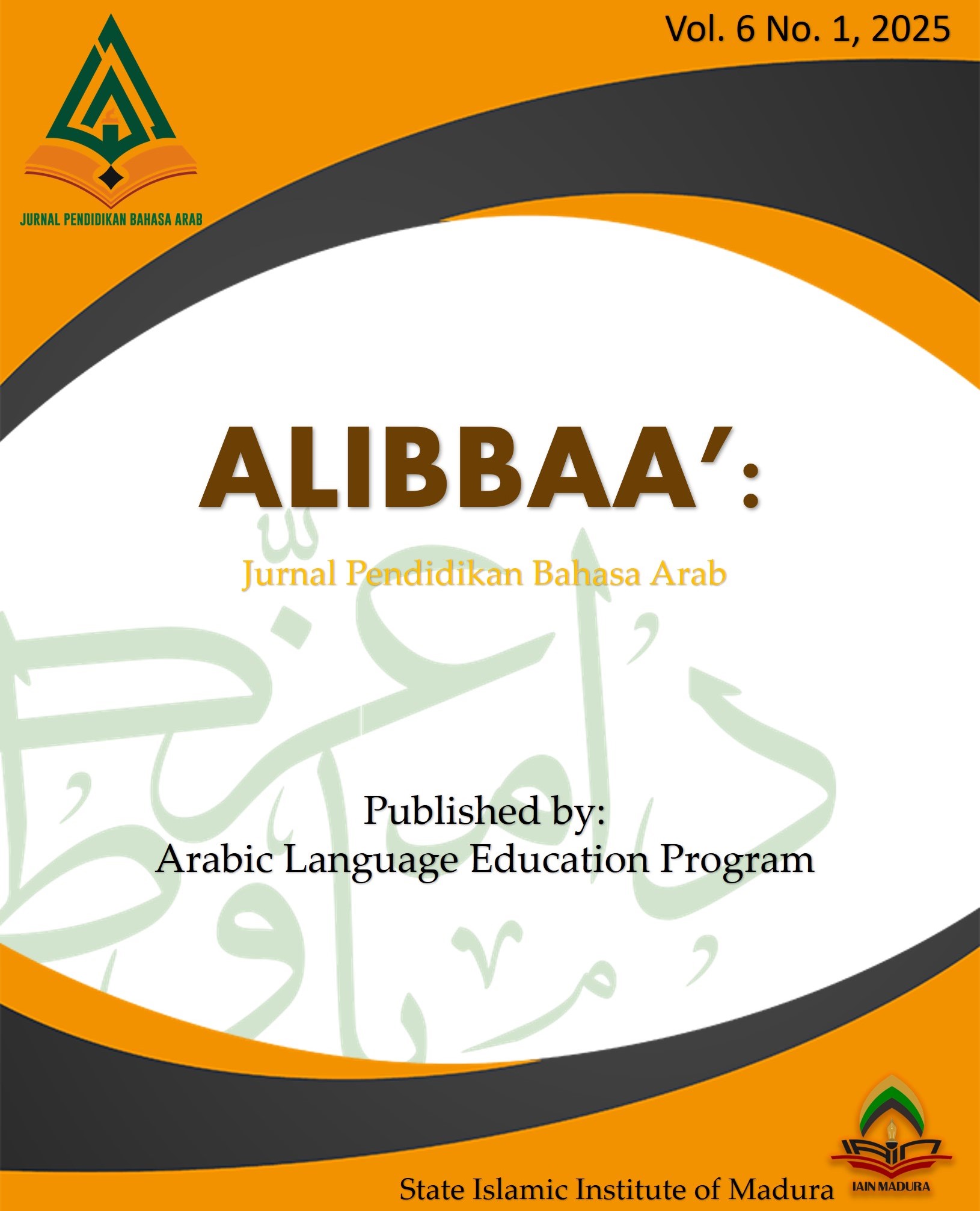Denotative and Connotative Meanings in the Dialogue of Capernaum: A Semiotic Approach to Nadine Labaki’s Work
 Abstract views: 178
,
Abstract views: 178
,
 pdf downloads: 134
pdf downloads: 134
Abstract
The study of denotative and connotative meanings in the Arabic language remains limited, particularly regarding how meanings evolve within social and ideological contexts in films. Most previous research has predominantly focused on semantic analysis without considering the connotative aspects that shape social perceptions and representations. This study aims to analyze the denotative and connotative meanings of selected Arabic words using a qualitative approach through the perspective of Roland Barthes' Semiotics. Data were collected through non-participant observation and note-taking, while analysis was conducted using extralingual referential analysis, employing both comparative and contrastive methods. The findings reveal that words such as قيود, الجحيم, الإيجار, خادمة, and الهارب in the film Capernaum carry connotative meanings that reflect social constraints, suffering, exploitation, oppression, and the loss of identity. This study affirms that language is not merely a tool for communication but also an ideological instrument that represents social realities. This study implies that connotative meaning can enrich linguistic studies and provide deeper insights into language use across various social and cultural contexts.
Downloads
References
Al-Dala’ien, Othman Aref, Yasser Al-Shboul, Issam M. Aldowkat, and Ayman Al-Takhayinh. “Visualising the Russia-Ukraine War: A Semiotic Analysis of Arab Social Media Cartoons.” Theory and Practice in Language Studies 12, no. 12 (December 1, 2022): 2712–2722. https://doi.org/10.17507/tpls.1212.30.
Aridi, Sara. “‘Capernaum’ Is Not Just a Film, but a Rallying Cry.” The New York Times, December 14, 2018, sec. Movies. https://www.nytimes.com/2018/12/14/movies/capernaum-nadine-labaki.html. (10 Oktober 2024)
Ayati, Alima Nuri, Khomisah Khomisah, Karman Karman, and Amiq Amiq. “Realisasi Hak Anak Dalam Film Capharnaum Karya Nadine Labaki (Kajian Strukturalisme Obyektif).” Az-Zahra: Journal of Gender and Family Studies 1, no. 2 (June 20, 2021): 88–105. https://doi.org/10.15575/azzahra.v1i2.11606.
Aziz Amen, Mustafa, and Hourakhsh Ahmad NIA. “The Effect of Cognitive Semiotics on The Interpretation of Urban Space Configuration.” In Proceedings Article, 260–74. Alanya Hamdullah Emin Paşa University, 2021. https://doi.org/10.38027/ICCAUA2021227n9.
Barthes, Roland. Elemen-Elemen Semiologi. Hill and Wang, New York: IRCiSoD, 1968.
Dianiya, Vicky. “REPRESENTATION OF SOCIAL CLASS IN FILM (Semiotic Analysis of Roland Barthes Film Parasite).” Profetik: Jurnal Komunikasi 13, no. 2 (December 31, 2020): 212. https://doi.org/10.14421/pjk.v13i2.1946.
Eka Pratiwi, Desak Putu, I Komang Sulatra, and I Putu Ayu Putri Rahayu. “Make It Happen: A Study of Verbal and Non-Verbal Signs Representing Feminism in an English Language Advertisement in ESL Setting.” Journal of Language and Linguistic Studies 17, no. 3 (September 22, 2021): 1551–1565. https://doi.org/10.52462/jlls.112.
Fiantika, Feny Rita, Mohammad Wasil, Sri Jumiyati, Leli Honesti, Sri Wahyuni, Erland Mouw, Jonata, et al. Metodologi Penelitian Kualitatif. Padang: PT. Global Eksekutif Teknologi, 2022.
Fiddin, Muthi’ah. “Pesan Kekerasan dalam Film Capernaum Karya Nadine Labaki,” n.d.
Hamsiah, Andi, Ratri Wikaningtyas, Jimiana Bunga, Eva Eri Dia, Maisaroh, Siti, Mu’minin, Yusi Kurniati, Ida Sukowati, and Serapina. Pengantar Bahasa Dan Sastra Indonesia. Jambi: PT. Sonpedia Publishing Indonesia, 2023.
Hidayah, Reni Lailina. “Makna Referensial Pada Komik Bahasa Arab Nawâdhîr Jûhâ Li Al-Athfâl.” Alibbaa’: Jurnal Pendidikan Bahasa Arab 2, no. 1 (February 19, 2021): 1–23. https://doi.org/10.19105/ajpba.v2i1.4130.
Mahsun. Metode Penelitian Bahasa: Tahapan, Strategi, Metode, Dan Tekniknya. Jakarta: PT RajaGrafindo Persada, 2014.
Maulidiyah, Miya. “The Makna Denotasi dan Makna Konotasi Dalam Film Animasi ‘Amirotur Ruum’ Karya Hadi Mohammadian: Semiotika Roland Barthes.” Al-Ma‘rifah 18, no. 2 (December 1, 2021): 151–162. https://doi.org/10.21009/almakrifah.18.02.04.
Mazeree, Nur Syasya Qistina, Norhakimin Ashaari, Nadzirah Munirah Ramli, and Nur Arifah Zahiah Zuri. “A Semiotic Analysis on Confession of a Shopaholic Trailer: Roland Barthes Approach.” LET: Linguistics, Literature and English Teaching Journal 13, no. 2 (December 25, 2023): 212–32. https://doi.org/10.18592/let.v13i2.11640.
Meliyana, and Medo Maulinza. “Analisis Semiotika Roland Barthes: Citra Perempuan Mandiri Dalam Film Ali & Ratu-Ratu Queens.” Jurnal Sosial dan Humaniora 1, no. 3 (2024): 328–343. https://doi.org/10.62017/arima.v1i3.934.
Nugraha, Oktavian Aditya. “Pemerolehan Bahasa Anak Usia 4 Tahun Kajian Semantik Penyimpangan Tuturan Anak.” Kajian Linguistik dan Sastra 2, no. 2 (August 31, 2018): 104–110. https://doi.org/10.23917/kls.v2i2.6733.
Nurhasanah Purba, and Khairunnisa Tambunan. “Semiotic Analysis of Roland Barthes on Wardah Advertisement Version ‘I Face of Indonesia.’” LingLit Journal Scientific Journal for Linguistics and Literature 2, no. 3 (September 27, 2021): 113–26. https://doi.org/10.33258/linglit.v2i3.511.
Nursalim, Misbah Priagung, and Syafiqa Ayu Permata. “Makna Semiotik dalam Film Pasukan Garuda: I Leave My Heart in Lebanon.” Disastra: Jurnal Pendidikan Bahasa dan Sastra Indonesia 6, no. 1 (April 30, 2024): 63-77. https://doi.org/10.29300/disastra.v6i1.3309.
Pratiwi, Ardhina. “Representasi Citra Politik Harry Tanoesoedibjo (Studi Semiotika Roland Barthes Dalam Video Mars Partai Perindo).” Profetik: Jurnal Komunikasi 11, no. 2 (December 19, 2018). https://doi.org/10.14421/pjk.v11i2.1426.
Poizat, Germain, Simon Flandin, and Jacques Theureau. “A Micro-Phenomenological and Semiotic Approach to Cognition in Practice: A Path toward an Integrative Approach to Studying Cognition-in-the-World and from Within.” Adaptive Behavior 31, no. 2 (April 15, 2023): 109–25. https://doi.org/10.1177/10597123211072352.
Rohanda, Rohanda. Model Penelitian Sastra Interdisipliner. Bandung: Adabi Press, 2005.
Sobur, Alex. Semiotika Komunikasi. Bandung: PT Remaja Rosdakarya, 2003.
Talibong, Emelyn Magsipoc. “Semiotic Analysis of Joyce Kilmer’s Poems,” n.d.
Taufiq, Wildan. Semiotika Untuk Kajian Sastra Dan Al-Qur’an. Bandung: Yrama Widya, 2016.
Trimo Wati, Trimo Wati, Dina Safira Ikmaliani, and Mustolehudin. “Representasi Makna Denotasi Dan Konotasi Dalam Lirik Lagu Kun Fayakun (Analisis Semiotika Roland Barthes).” Alibbaa’: Jurnal Pendidikan Bahasa Arab 3, no. 1 (January 24, 2022): 73–102. https://doi.org/10.19105/ajpba.v3i1.5172.
Wibisono, Panji. “Analisis Semiotika Roland Barthes dalam Film Bintang Ketjil Karya Wim Umboh dan Misbach Yusa Bira” 1, no. 1 (2021).
Yaskur, Muhammad Yazid. “Film Spongebob Squarepants Episode 9 ‘Uh, Bulu Babi,’” n.d.
Yunus, Mahmud. “Kamus Arab Indonesia,” 1–510. Jakarta: PT. Mahmud Yunus Wa Dzurriyyah, 2010.
Zahrah, Haiva Satriana. “Analisis Semilogi Roland Barthes Pada Term Zahrah Dalam Al-Qur’an.” Al Muhafidz: Jurnal Ilmu Al-Qur’an Dan Tafsir 3, no. 2 (September 4, 2023): 117–130. https://doi.org/10.57163/almuhafidz.v3i2.76.
Authors who publish with this journal agree to the following terms:
a. Authors retain copyright and grant the journal right of first publication with the work simultaneously licensed under a Creative Commons Attribution License that allows others to share the work with an acknowledgement of the work's authorship and initial publication in this journal.
b. Authors are able to enter into separate, additional contractual arrangements for the non-exclusive distribution of the journal's published version of the work (e.g., post it to an institutional repository or publish it in a book), with an acknowledgement of its initial publication in this journal.
c. Authors are permitted and encouraged to post their work online (e.g., in institutional repositories or on their website) prior to and during the submission process, as it can lead to productive exchanges, as well as earlier and greater citation of published work (See The Effect of Open Access).
Alibbaa': Jurnal Pendidikan Bahasa Arab have CC-BY-SA or an equivalent license as the optimal license for the publication, distribution, use, and reuse of scholarly work.
In developing strategy and setting priorities, Alibbaa': Jurnal Pendidikan Bahasa Arab recognize that free access is better than priced access, libre access is better than free access, and libre under CC-BY-SA or the equivalent is better than libre under more restrictive open licenses. We should achieve what we can when we can. We should not delay achieving free in order to achieve libre, and we should not stop with free when we can achieve libre.

Alibbaa': Jurnal Pendidikan Bahasa Arab is licensed under a Creative Commons Attribution 4.0 International License
You are free to:
- Share — copy and redistribute the material in any medium or format
- Adapt — remix, transform, and build upon the material for any purpose, even commercially.
- The licensor cannot revoke these freedoms as long as you follow the license terms.











